Collecting Assets for Translation
The first step in sending assets out for translation is collecting the assets from Oracle Eloqua.
- You can collect all translatable assets from a campaign canvas in Oracle Eloqua and add them to the Lionbridge App. This is the recommended method for collecting assets for translation as you work on a campaign canvas. For details, see Collecting Assets from a Campaign Canvas in Oracle Eloqua.
Tip: If a campaign canvas is open for editing in Oracle Eloqua, then opening the Lionbridge App automatically collects the assets on the campaign canvas and displays them in the New Translatio page.
- You can collect one asset from within Oracle Eloqua and add it to the Lionbridge App. This is the recommended method for collecting assets for translation as you work on them individually. For details, see Collecting One Asset from within Oracle Eloqua.
Tip: If an asset is open for editing in Oracle Eloqua, then opening the Lionbridge App automatically collects the asset and displays it in the New Translation page.
After you collect assets, you can view them before you send them out for translation. For details, see Viewing Collected Assets.
1 - Collecting Assets from a Campaign Canvas in Oracle Eloqua
You can collect all translatable assets from a campaign canvas in Oracle Eloqua and add them to the Lionbridge App. This is the recommended method for collecting assets for translation as you work on a campaign canvas.
If a campaign canvas is open for editing in Oracle Eloqua, then opening the Lionbridge App automatically collects the assets on the campaign canvas and displays them in the New Translation page.
To automatically collect all translatable assets from a campaign canvas in Oracle Eloqua:
- Log into Oracle Eloqua.
The My Eloqua dashboard opens.
-
In the top menu, click Orchestration and select Campaign.
-
Either:
- Create a new campaign.
- Open an existing campaign by clicking a link in the left menu to search for existing campaigns, then double-click the campaign name to open it.
Note: For more information about working in Oracle Eloqua, refer to the Oracle Eloqua Help Center, at: http://docs.oracle.com/cloud/latest/marketingcs_gs/OMCAA/index.html.
- When the campaign editor is open, in the top-right corner, click the More Apps button
 .
.
The Apps area opens.

- Click Lionbridge App for Eloqua.
A message box opens, prompting you to grant permission to the Lionbridge App to access Oracle Eloqua on your behalf.
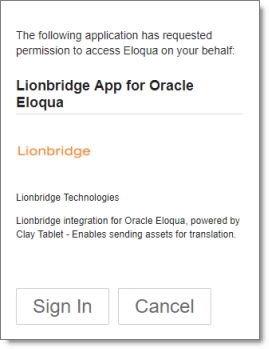
- Click Sign In.
A message box opens, prompting you to sign in as the user who is currently logged into Oracle Eloqua.

- Click Accept.
The New Translation page opens, displaying the asset that is open in the asset-specific design editor, with its check box selected.
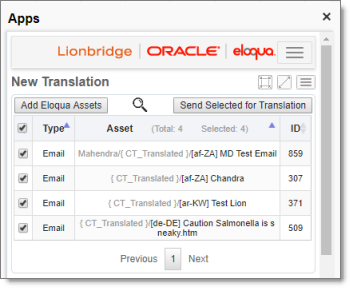
- To immediately send out this asset for translation or to send it to the Translation Queue, so that you can send it later, click Send Selected for Translation. For detailed instructions, see Sending Assets for Translation.
2 - Collecting One Asset from within Oracle Eloqua
If an asset is open for editing in Oracle Eloqua, then opening the Lionbridge App automatically collects the asset and displays it in the New Translation page.
Note about embedded forms: If a form is embedded inside another asset, such as a landing page, then both the embedded form and the asset that contains it are collected for translation.
To automatically collect one asset for translation from within Oracle Eloqua:
- Log into Oracle Eloqua.
The My Eloqua dashboard opens.
-
In the top menu, click Assets and select an asset type. For example, click Assets and select Emails.
-
Open an existing asset in an asset-specific design editor, or create a new asset. For example, click a link in the left menu to search for existing emails, then double-click the email name to open it.
Note: For more information about working in Oracle Eloqua, refer to the Oracle Eloqua Help Center, at: http://docs.oracle.com/cloud/latest/marketingcs_gs/OMCAA/index.html.
- When the asset-specific design editor is open, in the top-right corner, click the Apps button
 .
.
The Apps area opens.

- Click Lionbridge App for Eloqua.
A message box opens, prompting you to grant permission to the Lionbridge App to access Oracle Eloqua on your behalf.

- Click Sign In.
A message box opens, prompting you to sign in as the user who is currently logged into Oracle Eloqua.

- Click Accept.
The New Translation page opens, displaying the asset that is open in the asset-specific design editor, with its check box selected.

- To immediately send out this asset for translation or to send it to the Translation Queue, so that you can send it later, click Send Selected for Translation. For detailed instructions, see Sending Assets for Translation.
3 - Collecting Assets for Translation from the Lionbridge App
You can collect one or more assets for translation from within the Lionbridge App. This is the recommended method for collecting multiple assets for translation. You can do one or both of the following:
Tip: This method is recommended for selecting many assets in the same branch of the tree.
3.1 - Adding Assets from the Eloqua Tree Structure
You can collect one or more assets for translation from within the Lionbridge App by adding them from the Eloqua tree structure. This is the recommended method for selecting many assets in the same branch of the tree.
To collect one or more assets for translation from within the Lionbridge App:
-
Open the Lionbridge App. For detailed instructions, see Getting Started with the Lionbridge App for Oracle Eloqua.
-
In the App, ensure that the New Translation page is open. This is the default selection when you open the App. For a detailed description of this page, see Viewing Collected Assets.

Note: If a maximized page in the App is already open, then in the Lionbridge App for Eloqua menu on the left, you can click New Translation to open the maximized version of this page, described in Viewing Collected Assets.
- Click Add Eloqua Assets.
The Select Eloqua Assets dialog box opens.
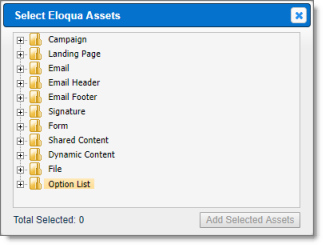
-
Click the expand icons  to view assets.
to view assets.
-
Select the check boxes of assets to send out for translation.
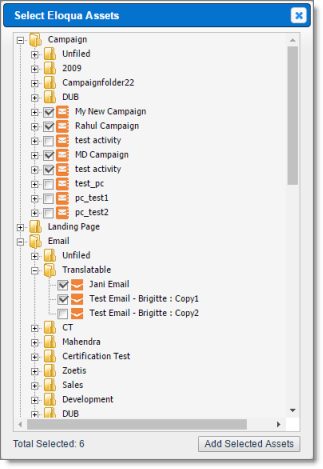
Note: You can expand and select assets from multiple branches.
The Total Selected field at the bottom of the dialog box displays the number of selected assets.
- Click Add Selected Assets.
The dialog box closes, and the New Translation page refreshes, displaying the assets you collected for translation, with their check boxes selected.
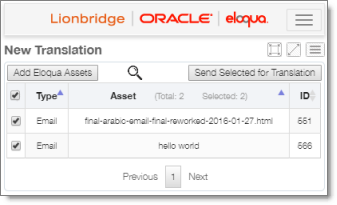
- To send out these assets for translation, click Send Selected for Translation. For detailed instructions, see Sending Assets for Translation.
Note: To change which assets you are sending out to translation, you can clear the check boxes of these assets or select the check boxes of other assets already on this page. However, all the assets must be in the same source language, and you must want to translate them into the same target languages.
3.2 - Searching for Assets to Collect
In the Lionbridge App, you can search for Eloqua assets to collect by asset type and name. This is the recommended method for locating a few assets in a large and complex tree.
To collect one or more assets for translation from within the Lionbridge App:
-
Open the Lionbridge App. For detailed instructions, see Getting Started with the Lionbridge App for Oracle Eloqua.
-
In the App, ensure that theNew Translation page is open. This is the default selection when you open the App. For a detailed description of this page, see Viewing Collected Assets.

Note: If a maximized page in the App is already open, then in the ionbridge App for Eloqua menu on the left, you can click New Translation to open the maximized version of this page, described in Viewing Collected Assets.
- Click the search icon
 .
.
TheSearch Eloqua Assets dialog box opens.
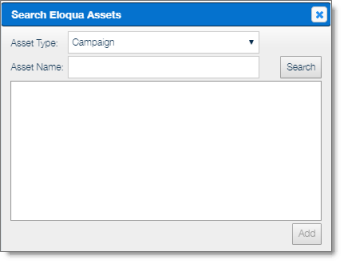
-
In the Asset Type list, select the type of assets to add. The default asset type is Campaign.
-
In the Asset Name field, enter the full or partial name of the asset.
-
Click Search.
Thebottom pane displays the matching assets. The paths are displayed in gray, while the asset names are displayed in blue.

- Select the check boxes of assets to send out for translation.

- Click Add.
The dialog box closes, and theNew Translation page refreshes, displaying the assets you collected for translation, with their check boxes selected.

- To send out these assets for translation, click Send Selected for Translation. For detailed instructions, see Sending Assets for Translation.
Note: To change which assets you are sending out to translation, you can clear the check boxes of these assets or select the check boxes of other assets already on this page. However, all the assets must be in the same source language, and you must want to translate them into the same target languages.
4 - Viewing Collected Assets
In the New Translation page, you can view assets that have been collected for translation by you and your team members but that have not yet been sent out for translation or to the Translation Queue.
To view collected assets:
-
Open the Lionbridge App. For detailed instructions, see Getting Started with the Lionbridge App for Oracle Eloqua.
-
In the App, ensure that the New Translation page is open. This is the default selection when you open the App.

Note: If a maximized page in the App is already open, then in the Lionbridge App for Eloqua menu on the left, you can click New Translation to open the maximized version of this page, described below.
The Asset column heading displays the number of collected assets displayed in the current sub-page and the total number of collected assets in this page.
By default, the items are sorted in alphabetical order first by the Type column and then by asset name, in the Asset column.
This page displays the following information about assets that you and your team members collected that have not yet been sent out for translation or added to the Translation Queue.
| Column |
Description |
| Type |
The type of asset in Eloqua. |
| Asset |
The name of the asset in Eloqua. |
| ID |
The Lionbridge App’s unique identifier for this asset. |
- To sort the items in the tab by a different column, click the corresponding column header.
- To reverse the sort order of a column, click the column header.
- Optional. You can perform any of the following actions:
- To search for additional Eloqua assets by asset type and asset name so that you can add them to this page, click the search icon
 . For detailed instructions, see Searching for Assets to Collect.
. For detailed instructions, see Searching for Assets to Collect.
- To collect additional Eloqua assets from the tree structure and add them to this page, click Add Eloqua Assets. For detailed instructions, see Adding Assets from the Eloqua Tree Structure.
- To send assets on this page out for translation as a single job, select the corresponding check boxes and click Send Selected for Translation. For detailed instructions, see Sending Assets for Translation.
- To send assets on this page to the Translation Queue, so that you can group them into jobs later, select the corresponding check boxes and click Send Selected for Translation. For detailed instructions, see Sending Assets for Translation from the Translation Queue.
Note: Assets in the Translation Queue are actually just pointers to the assets in Eloqua. If you modify an asset within Eloqua after adding it to the queue, those changes are included in the version sent out for translation.
Tip: To select or clear all check boxes, select or clear all check boxes in the header row.
- Optional. You can view additional information about each asset and perform additional actions on the maximized version of this page:

To open the maximized version of this page, click the Maximize Window button  .
.
The maximized version of the queue displays the following information about assets that you and your team members collected that have not yet been sent out for translation or added to the Translation Queue.
| Column |
Description |
| Type |
The type of asset in Eloqua. |
| Asset |
The name of the asset in Eloqua. This includes the full folder path. |
| ID |
The Lionbridge App’s unique identifier for this asset. |
| Last Modified At |
The date and time when this asset was last modified, in the following format: YYYY-MM-DD hh:mm:ss AM/PM. If the asset was not modified after creation, this is the same as the Created On date and time, described below.
Note: This information is not displayed for items in an Eloqua Option List (pick list), because it is not available. |
| Last Modified By |
The username of the user who last modified this asset.
Note: This information is not displayed for items in an Eloqua Option List (pick list), because it is not available. |
| Created On |
The date and time when this asset was created, in the following format: YYYY-MM-DD hh:mm:ss AM/PM.
Note: This information is not displayed for items in an Eloqua Option List (pick list), because it is not available. |
| Created By |
The username of the user who last modified this asset.
Note: This information is not displayed for items in an Eloqua Option List (pick list), because it is not available. |
You can do one or more of the following on this page:
-
If there are many items in this page, it may have multiple sub-pages. The navigation bar below the list helps you navigate through the sub-pages and displays your position in the tab. Click Previous Page, Next Page, or a page number to navigate to the corresponding sub-page.
-
You can specify how many items to display in a page. Above the top-left corner of the list, select the number to display from the Show X Entries list.
-
You can use the Search box above the top-right corner of the list to search for a specific asset in the list or to filter the list. As you type into the Search box, the Lionbridge App automatically searches for matches across all columns and displays only the matching assets.
Note: The search feature filters all items in the page, not only those displayed on the current sub-page.












